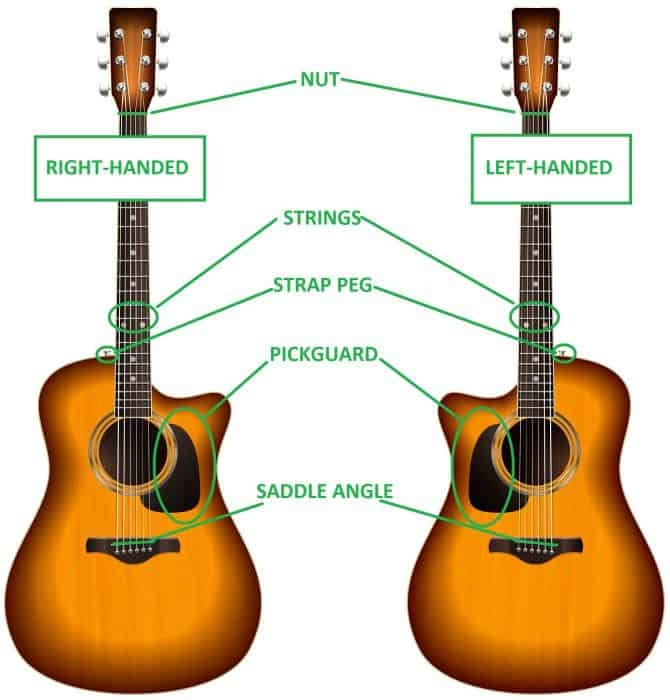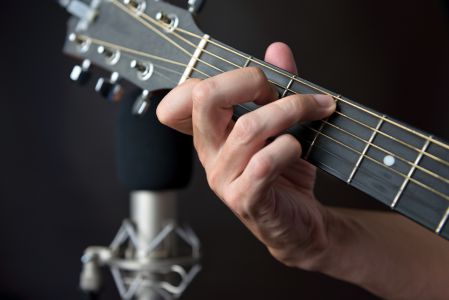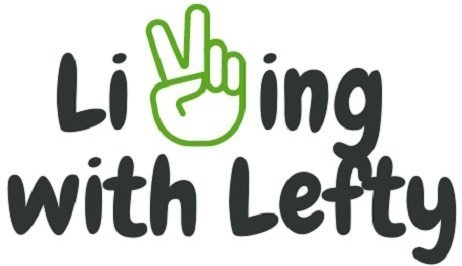If you’re looking to buy a guitar, do you know how to tell between a left handed vs right handed guitar at the store? Because of poor demand for left handed guitars, most music stores won’t have many options of them, so if you’re browsing a wall of guitars, you may not see one at all. On the other hand, if you don’t know what to look for, you could miss a left handed guitar entirely. But is there a difference between left and right handed guitars or can you just turn any guitar the other way and start playing? Well, the answer is yes, there is a difference. A lefty guitar is a mirror version of a righty guitar, so you can’t just flip it and expect it to be just as easy to play as it is for right-handed players.
Table of Contents
What to Look for When Buying a Guitar
When it comes to purchasing a new guitar, there are five essential pointers that the buyers will have to consider, irrespective of whether they are left or right-handed. These are:
- Checking the ability of the guitar to stay in tune.
- Making sure that the neck of the guitar is not bent, which may make it difficult for the strings to hit the frets.
- Determining that the strings are not too far from the fretboard.
- Checking whether you’re able to reach the entire length of the fretboard with ease.
- Choosing a guitar that fits your abilities the best.
Are There Left Handed Guitars?
There was a period when it was extremely difficult for left-handed musicians to obtain instruments designed specifically for them. Some well-known left-handed artists, such as Jimi Hendrix and Albert King, were known to play standard guitars upside down to make things simpler for themselves. This is completely unheard of when it comes to famous left-handed piano players.
However, as the appeal of music as a creative pursuit has grown, so have the expectations, and instrument makers have responded by developing more options and being more inclusive with their offerings. As a result, left-handed musicians today can more easily choose a guitar or even a left-handed violin that meets their requirements. Different brands provide a diverse selection of electric, bass, and acoustic guitars.
Left Vs Right Handed Guitar

Orientation
In the case of a right-handed guitar, the guitarists use their left hand for fretting and their right hand for playing the strings. In the case of a left-handed guitar, it is the opposite. The guitarists use their right hand to keep on the fretboard and their left hand to strum the strings of the guitar. Most classical guitars can be played in both ways by switching the order of the string, thus, making it possible for both left as well as right-handed musicians to play the the same guitar.
Visually, a left-handed guitar is just the opposite of a right-handed guitar. It is a flipped or a mirrored image of a right-handed guitar when it comes to its physical appearance.
Guitar Anatomy
Some of the significant differences between left-handed and right-handed guitars are present in the manner in which they’ve been built. Some of the anatomical differences between them are:
- Nut
A nut is the piece of hard material that supports the strings of the guitar at its end nearest to the headstock.
On any guitar, when you’re holding it in the normal playing position, the strings of the guitar are thicker at the top, thus, creating a more significant groove on the top of the nut. If you hold a right-handed guitar upside down with your right hand on the fretboard and left hand plucking the strings, the more prominent grooves will be at the bottom of the guitar.
- Pickguard
If you hold a guitar vertically to face you, the pickguard is to the right of the strings on a right-handed guitar in order to stop scuff marks from appearing while playing the guitar. This pickguard is placed on the left side when it comes to left-handed guitars for the same reason.
This pointer may not be considered in some cases since some guitars, particularly classical guitars, do not have these pickguards incorporated.
- Saddle angle
The saddle on acoustic guitars is the layer of thin material that sits on top of the bridge of the guitar and has the strings of the guitar lying over it. On right-handed guitars, this saddle is placed at such an angle that makes it possible for the thickest string to have the most extended length, hence, setting the intonation of the guitar. Sometimes, while flipping a guitar in order to turn it into a left-handed guitar, this angle or crookedness of the saddle is not reversed while the strings are reversed, thus, making it challenging to play the guitar.
This is not an issue when it comes to electric guitars since most of them have a floating or an adjustable bridge which makes it possible to flip the guitar to the guitarist’s preference easily. The only issue in this whole process is that the controls and tuners of the guitar might end up in places that are less convenient for players.
- Strap pegs
One of the markers that will help buyers in differentiating between a right-handed guitar and a flipped left-handed guitar are the strap pegs, which are the tiny metal buttons to which the strap of the guitar is attached. On a regular guitar, the rear strap peg is positioned in the center of the body, while the front strap peg is located on the top and close to where the neck meets the body. But on a flipped guitar, the peg would be located at the bottom unless it has been moved to the opposite side and the hole is filled in.
- Fretboard side markers
These markers are the white dots on the top side of the fretboard that mark the fret positions. When you’re playing the dots are directly visible when you look down. If they are located at the bottom, then it implies that the guitar is a flipped guitar.
6. The strings
Standard tuning for the acoustic guitar is: E – A – D – G – B – e, starting at the neck’s thickest, lowest-pitched string (the 6th string), which is strung right on the top of the neck. The High E string (e) is known as the 1st string, it’s the thinnest, highest pitch of all the strings in the instrument and is strung at the bottom of the neck. Reading chords and tabs for when you’re a beginner is especially challenging for left-handers learning to play guitar.
Related article: Can a Left-Handed Person Play the Flute
What Makes a Guitar Left Handed?

Left-handed guitars are a mirrored version of right-handed ones, with most of the properties of the guitar placed at a location that is opposite to the ones on standard guitars. There are three ways in which a guitar can be left-handed:
- Restringing a right-handed guitar: Initially, musicians like Jimi Hendrix resorted to the tedious process of restringing a standard right-handed guitar. Restringing a right-handed guitar to change its orientation is a long process. You often also have to flip the saddle and the nut and that comes with its own problems, such as the danger of damaging the guitar forever or reducing the resale value of the instrument. If you go this route, you should get it done by a professional.
- Flipping the right-handed guitar without restringing: Some guitarists choose to flip a right-handed guitar and play it with the strings intact and upside-down, even though this presents its own set of challenges. In the case of electric guitars and bass guitars, the pots, switches, and plugs can end up in an inconvenient place. Eric Gales famously plays a right-handed guitar upside down, not because he’s naturally left-handed but because he was taught by his lefty brother. Check out an Eric Gales performance below!
- Buying a left-handed guitar specially made for the lefties: Today, there is a wide array of guitars available in the market and many come in right-handed and left-handed versions. This is the best option even if the left-handed version costs a little bit more. In the case of the best left handed acoustic guitars for beginners, there’s barely any price difference.
How is a Left Handed Guitar Strung?
A left-handed guitar is strung exactly the same as a right-handed one, with the top string on the neck being the 6th string, which is the thickest and lower pitch and the 1st string, which is the thinnest and highest pitch, at the bottom. Make sure that the grooves in the nut match this order too.
Are Left Handed Guitars More Expensive?
Compared to right-handed models, many left-handed ones cost the same or maybe about 10% more as a surcharge by the manufacturer. Since such a small percentage of guitarists are left-handed, left-handed guitars move more slowly and it may not make sense to keep them in stock at all in smaller music stores. This is the main reason for the price difference between a righty vs lefty guitar.
However, this small surcharge is not a good enough reason to buy a right handed guitar if you’re a left-hander. The cost of going through the whole process of restringing a standard guitar can be more. Besides, if you ultimately don’t continue learning to play guitar left-handed or you want to upgrade to a better model later on, the sale value of your left handed guitar will be more than that of the right-handed equivalent.
The only reason to buy a right handed guitar is if you really want to play a particular brand and model that doesn’t come in a left handed version.
Sources:
